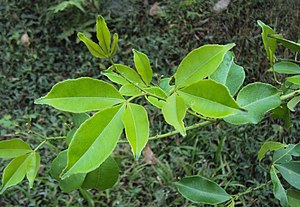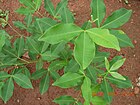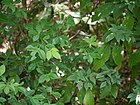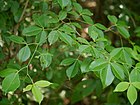Note: This is a project under development. The articles on this wiki are just being initiated and broadly incomplete. You can Help creating new pages.
Difference between revisions of "Toddalia asiatica"
| (2 intermediate revisions by the same user not shown) | |||
| Line 1: | Line 1: | ||
| − | + | [[File:Toddalia asiatica 11.JPG|thumb|right|''Toddalia asiatica'']] | |
| + | '''Toddalia asiatica''' is a prickly, climbing, evergreen shrub producing stems from 2 - 20 metres long. The stems attach themselves to other plants for support by means of their sharp, recurved prickles. When growing in an open, sunny position, the plant often grows as a shrub and does not climb. The plant is harvested from the wild for local use as a food, medicine and source of dyes and essential oils. It is sometimes cultivated for medicinal use and is also grown as a hedge. | ||
==Uses== | ==Uses== | ||
| − | {{Uses|}}, {{Uses|}}, {{Uses|}}, {{Uses|}}, {{Uses|}}, {{Uses|}}, {{Uses|}}, {{Uses|}}, {{Uses|}}, {{Uses| | + | {{Uses|Fever}}, {{Uses|Indigestion}}, {{Uses|Cough}}, {{Uses|Influenza}}, {{Uses|Malaria}}, {{Uses|Cholera}}, {{Uses|Diarrhoea}}, {{Uses|Rheumatism}}, {{Uses|Asthma}}, {{Uses|Lung diseases}}.<ref name="Uses"/> |
==Parts Used== | ==Parts Used== | ||
| − | {{Parts Used| | + | {{Parts Used|Fruits}}. |
==Chemical Composition== | ==Chemical Composition== | ||
| − | <ref name="chemical composition"/> | + | Sixteen compounds were isolated and identified as zanthocadinanine A(1), pimpinellin(2), isopimpinellin(3), phellopterin (4), armottianamide(5), chelerythrine(6), nitidine(7), chlorogenic acid (8), toddalolactone (9), protopine(10), skimmianine(11), dictamine(12), toddalenone(13), beta-sitosterol(14), bergapten(15) and 8-hydroxy-6-methoxycoumarin(16).<ref name="chemical composition"/> |
==Common names== | ==Common names== | ||
| Line 16: | Line 17: | ||
===Dravya=== | ===Dravya=== | ||
===Rasa=== | ===Rasa=== | ||
| − | |||
===Guna=== | ===Guna=== | ||
| Line 29: | Line 29: | ||
==Habit== | ==Habit== | ||
| − | {{Habit|}} | + | {{Habit|Evergreen climber}} |
==Identification== | ==Identification== | ||
| Line 48: | Line 48: | ||
==Mode of Propagation== | ==Mode of Propagation== | ||
| − | {{Propagation|}} | + | {{Propagation|Seeds}}, {{Propagation|Cuttings}}. |
==How to plant/cultivate== | ==How to plant/cultivate== | ||
| − | <ref name="How to plant/cultivate"/> | + | A plant of subtropical to tropical climates, it will only flourish in frost-free areas with a fairly high annual rainfall.<ref name="How to plant/cultivate"/> |
==Commonly seen growing in areas== | ==Commonly seen growing in areas== | ||
| − | {{Commonly seen|}}, {{Commonly seen|}}, {{Commonly seen|}}, {{Commonly seen| | + | {{Commonly seen|Forests near rivers}}, {{Commonly seen|Thickets}}, {{Commonly seen|Forests near coasts}}, {{Commonly seen|Humid forests}}. |
==Photo Gallery== | ==Photo Gallery== | ||
<gallery class="left" caption="" widths="140px" heights="140px"> | <gallery class="left" caption="" widths="140px" heights="140px"> | ||
| − | + | Kaakka thutali 94.jpg | |
| + | Tiksnaksah (Sanskrit- तीक्ष्णक्षः) (8291294146).jpg | ||
| + | Toddalia asiatica (16712222043).jpg | ||
| + | Toddalia asiatica (17144925790).jpg | ||
| + | Toddalia asiatica (17332510475).jpg | ||
</gallery> | </gallery> | ||
| Line 64: | Line 68: | ||
<references> | <references> | ||
| − | <ref name="chemical composition">[ | + | <ref name="chemical composition">[https://pubmed.ncbi.nlm.nih.gov/25857161/ Chemical constituents]</ref> |
| − | <ref name="Leaf">[ | + | <ref name="Leaf">[Morphology]</ref> |
<ref name="Common names">[https://sites.google.com/site/indiannamesofplants/via-species/t/toddalia-asiatica Common names]</ref> | <ref name="Common names">[https://sites.google.com/site/indiannamesofplants/via-species/t/toddalia-asiatica Common names]</ref> | ||
| − | <ref name="How to plant/cultivate">[ | + | <ref name="How to plant/cultivate">[http://tropical.theferns.info/viewtropical.php?id=Toddalia+asiatica Cultivation]</ref> |
<ref name="Uses">Indian Medicinal Plants by C.P.Khare</ref> | <ref name="Uses">Indian Medicinal Plants by C.P.Khare</ref> | ||
</references> | </references> | ||
==External Links== | ==External Links== | ||
| − | * [ ] | + | * [https://indiabiodiversity.org/species/show/250752 Toddalia asiatica on indiabiodiversity.org] |
| − | * [ ] | + | * [http://pza.sanbi.org/toddalia-asiatica Toddalia asiatica on pza.sanbi.org] |
| − | + | ||
[[Category:Herbs]] | [[Category:Herbs]] | ||
Latest revision as of 12:57, 25 August 2020
Toddalia asiatica is a prickly, climbing, evergreen shrub producing stems from 2 - 20 metres long. The stems attach themselves to other plants for support by means of their sharp, recurved prickles. When growing in an open, sunny position, the plant often grows as a shrub and does not climb. The plant is harvested from the wild for local use as a food, medicine and source of dyes and essential oils. It is sometimes cultivated for medicinal use and is also grown as a hedge.
Contents
- 1 Uses
- 2 Parts Used
- 3 Chemical Composition
- 4 Common names
- 5 Properties
- 6 Habit
- 7 Identification
- 8 List of Ayurvedic medicine in which the herb is used
- 9 Where to get the saplings
- 10 Mode of Propagation
- 11 How to plant/cultivate
- 12 Commonly seen growing in areas
- 13 Photo Gallery
- 14 References
- 15 External Links
Uses
Fever, Indigestion, Cough, Influenza, Malaria, Cholera, Diarrhoea, Rheumatism, Asthma, Lung diseases.[1]
Parts Used
Chemical Composition
Sixteen compounds were isolated and identified as zanthocadinanine A(1), pimpinellin(2), isopimpinellin(3), phellopterin (4), armottianamide(5), chelerythrine(6), nitidine(7), chlorogenic acid (8), toddalolactone (9), protopine(10), skimmianine(11), dictamine(12), toddalenone(13), beta-sitosterol(14), bergapten(15) and 8-hydroxy-6-methoxycoumarin(16).[2]
Common names
| Language | Common name |
|---|---|
| Kannada | Dodda kadu menasu |
| Hindi | Jangali kalimirch |
| Malayalam | Kakkattutali |
| Tamil | Kattu-milaku |
| Telugu | Kondakasinda |
| Marathi | Dahan |
| Gujarathi | |
| Punjabi | |
| Kashmiri | |
| Sanskrit | Dahana |
| English | Forest pepper, Orange climber |
Properties
Reference: Dravya - Substance, Rasa - Taste, Guna - Qualities, Veerya - Potency, Vipaka - Post-digesion effect, Karma - Pharmacological activity, Prabhava - Therepeutics.
Dravya
Rasa
Guna
Veerya
Vipaka
Karma
Prabhava
Habit
Identification
Leaf
| Kind | Shape | Feature |
|---|---|---|
Flower
| Type | Size | Color and composition | Stamen | More information |
|---|---|---|---|---|
| {{{5}}} |
Fruit
| Type | Size | Mass | Appearance | Seeds | More information |
|---|---|---|---|---|---|
Other features
List of Ayurvedic medicine in which the herb is used
Where to get the saplings
Mode of Propagation
How to plant/cultivate
A plant of subtropical to tropical climates, it will only flourish in frost-free areas with a fairly high annual rainfall.[5]
Commonly seen growing in areas
Forests near rivers, Thickets, Forests near coasts, Humid forests.
Photo Gallery
References
- ↑ Indian Medicinal Plants by C.P.Khare
- ↑ Chemical constituents
- ↑ Common names
- ↑ [Morphology]
- ↑ Cultivation
External Links
- Ayurvedic Herbs known to be helpful to treat Fever
- Ayurvedic Herbs known to be helpful to treat Indigestion
- Ayurvedic Herbs known to be helpful to treat Cough
- Ayurvedic Herbs known to be helpful to treat Influenza
- Ayurvedic Herbs known to be helpful to treat Malaria
- Ayurvedic Herbs known to be helpful to treat Cholera
- Ayurvedic Herbs known to be helpful to treat Diarrhoea
- Ayurvedic Herbs known to be helpful to treat Rheumatism
- Ayurvedic Herbs known to be helpful to treat Asthma
- Ayurvedic Herbs known to be helpful to treat Lung diseases
- Herbs with Fruits used in medicine
- Herbs with common name in Kannada
- Herbs with common name in Hindi
- Herbs with common name in Malayalam
- Herbs with common name in Tamil
- Herbs with common name in Telugu
- Herbs with common name in Marathi
- Herbs with common name in Sanskrit
- Herbs with common name in English
- Habit - Evergreen climber
- Index of Plants which can be propagated by Seeds
- Index of Plants which can be propagated by Cuttings
- Herbs that are commonly seen in the region of Forests near rivers
- Herbs that are commonly seen in the region of Thickets
- Herbs that are commonly seen in the region of Forests near coasts
- Herbs that are commonly seen in the region of Humid forests
- Herbs





